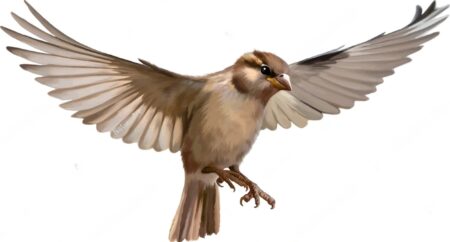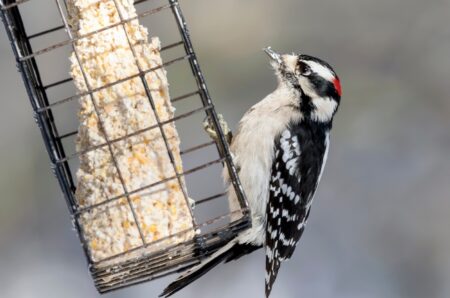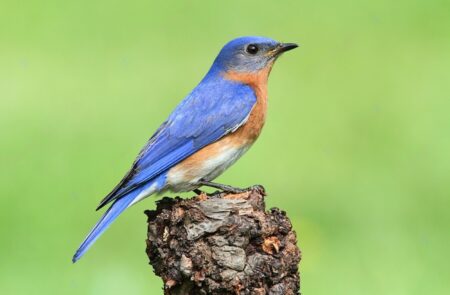What Do Birds Eat in The Winter?
As winter approaches, many birds face the challenge of finding food in colder climates. They are no longer able to rely on the abundance of insects, fruits, and seeds that are available during the warmer months. As a result, birds need to adapt their diet to survive the winter and stay nourished.
What exactly do birds eat in the winter? The answer to this question varies depending on the species and the location they live in. But in general, birds have three main sources of food in the winter: natural sources, human-provided sources, and stored food.
Natural sources: Many birds change their diet in the winter, shifting from insects and seeds to foods that are more readily available, such as berries, fruits, and nuts. These natural sources of food provide birds with important nutrients and energy to withstand the colder temperatures.
Some birds also rely on nectar from flowers, sap from trees, and small insects that are still active in the winter, such as beetles and caterpillars. These food sources may be scarce but can make a significant difference for birds struggling to find enough to eat.
Human-provided sources: Many bird enthusiasts enjoy feeding birds in their backyards, especially during the winter when food is scarce. Common bird feeders include seed feeders, suet feeders, and fruit feeders. These feeders can attract a variety of bird species, providing them with a reliable source of food during the winter months.
It’s important to note that not all birds will visit bird feeders, so providing a mix of natural and human-provided food sources can ensure that a wider variety of birds are able to find nourishment.
Stored food: Some bird species, such as chickadees and nuthatches, have the ability to store food for the winter. They will collect seeds and store them in tree bark crevices or under loose bits of bark. These birds have a remarkable ability to remember the locations of their stored food, allowing them to retrieve it when needed.
As winter progresses, birds may also rely on leftover food from the previous season, such as seeds left in plants or the leftover berries on bushes and trees.
What Do Birds Eat in The Winter?
Birds eat a variety of foods in the winter, depending on their species and the availability of food sources. Some common foods that birds eat in the winter include:
- Seeds: Many birds rely on seeds as their main source of food during the winter. These can include sunflower seeds, millet, thistle, and other types of seeds.
- Nuts: Nuts are an excellent source of fat and protein for birds in the winter. Some common nuts that birds eat include peanuts, almonds, and walnuts.
- Insects: While insects may be less abundant in the winter, some birds, such as woodpeckers and chickadees, will still feed on them during the colder months.
- Fruits and berries: Some birds, like robins and cedar waxwings, feed on fruits and berries during the winter. These can include crabapples, berries from shrubs, and other types of fruit.
- Suet: Suet is a high-energy food made from animal fat that is often used by birds in the winter. It can be found in the form of blocks or cakes and is typically hung in bird feeders.
- Nectar: Hummingbirds rely on nectar as their main food source in the winter. To provide nectar for hummingbirds, you can hang a feeder filled with sugar water.
- Table scraps: Many birds will eat table scraps, such as bread crumbs and leftover fruits or vegetables, during the winter when other food sources are scarce.
What Fruit Do Blackbirds Eat?
Blackbirds are opportunistic feeders and will eat a variety of fruits, including:
- Berries: Blackbirds are especially fond of berries, particularly those that are dark and ripe, such as blackberries, raspberries, blueberries, and elderberries.
- Apples: Blackbirds will peck at apples that are overly ripe or have fallen to the ground.
- Grapes: Blackbirds will eat grapes, both fresh and dried, and can often be seen feasting on them in vineyards.
- Cherries: Blackbirds will eat cherries, both sweet and tart varieties.
- Mulberries: Blackbirds will eat mulberries, which are a common food source for them in the wild.
- Plums: Blackbirds will eat ripe plums and can often be found in orchards picking at them.
- Currants: Blackbirds will eat currants, which are a small, dark berry that grows on shrubs.
- Hawthorn Berries: Blackbirds will eat hawthorn berries, which are small, red berries that grow on thorny shrubs.
- Juniper Berries: Blackbirds will eat juniper berries, which are small, blueberries that grow on coniferous plants.
What Do Small Birds Eat in The Wild
Small birds have a varied diet in the wild, but it primarily consists of insects, seeds, fruits, and nectar. They also eat small invertebrates, such as worms, snails, and spiders. Some birds, like hummingbirds, have a specialized diet of nectar and may also consume small insects to supplement their diet. Additionally, small grains and berries are a common food source for many species of wild birds. Some birds, like woodpeckers, may also eat tree sap and insects found in the bark of trees. Overall, small birds have a diverse diet that allows them to adapt to different environments and food availability.
SEE ALSO: How To Catch A Bird In Your House: Simple Steps
How Do Birds Survive in The Winter
Birds have evolved a variety of strategies to survive the harsh conditions of winter, such as:
- Migration: Some birds, such as geese, swans, and ducks, migrate to warmer climates during the winter. They travel long distances to find food and avoid freezing temperatures.
- Insulation: Birds have adapted to stay warm in the winter by growing thicker feathers and downy undercoats. These feathers trap air, creating a layer of insulation that helps them retain heat.
- Shivering: Similar to humans, birds can shiver to generate body heat in order to stay warm. Some small birds shiver constantly during the winter months to maintain their body temperature.
- Roosting: Many birds find shelter in trees or dense vegetation, where they can huddle together to conserve heat. Some birds also roost in natural cavities, such as tree holes or rock crevices, which provide protection from the elements.
- Food storage: Several species of birds, such as chickadees and nuthatches, store food during the fall to have a supply of food during the winter. They hide seeds and nuts in tree bark, crevices, and other hidden places, and retrieve them when food is scarce.
- Changing their diet: In the winter, when food sources are scarce, some birds may switch their diet to include more high-energy foods, such as seeds and nuts, instead of insects and fruits.
- Torpor: Some birds have the ability to enter a state of torpor, which is a kind of hibernation, to conserve energy during the cold winter nights. Their heart rate and metabolism slow down, allowing them to conserve energy and survive on fewer resources.
How Do Birds Find Food in the Winter?
Birds use a variety of strategies to find food in the winter, depending on their species and the availability of food sources in their environment. Some common methods include:
- Memory: Many birds have excellent spatial memory and are able to remember the locations of food sources from previous seasons. They may return to the same areas to find food that they remember from previous winters.
- Foraging techniques: Birds use a variety of techniques to locate and obtain food. Some may search for food on the ground, while others may actively hunt for insects, or use tools to extract food from hard-to-reach places.
- Seed storage: Some birds, such as nuthatches and chickadees, are known to store food for later use. They will stash seeds, nuts, and insects in crevices in trees or other sheltered places, and return to these caches throughout the winter.
- Flocking behavior: Many birds form flocks in the winter, which allows them to cover a larger area and increase their chances of finding food. In these groups, individual birds can watch their neighbors and quickly learn of any food sources that are discovered.
- Scavenging: In urban or suburban areas, birds may scavenge for food in human-populated areas, such as parks, backyards, and trash cans. This can include food such as seeds, nuts, scraps, or even pet food.
- Adapted diets: Some species of birds have adapted to survive on specific food sources that are available in the winter. For example, seed-eating birds may switch to a diet of insects, or birds that typically feed on insects may switch to berries or seeds.
- Migration: Many birds, especially those that breed in the northern regions, will migrate to warmer areas during the winter months. This allows them access to more abundant food sources and avoids the harsh conditions of their breeding grounds.
What to Feed Birds in Winter from The Kitchen
During the winter, when natural food sources are scarce, birds rely on backyard feeders for their survival. Here are some kitchen scraps and food items that you can feed birds in winter:
- Suet cakes or blocks: Suet is a high-fat food that provides energy and insulation for birds during the cold winter months. You can purchase pre-made suet cakes or make your own using rendered fat, seeds, and other bird-friendly ingredients.
- Peanut butter: Birds love peanut butter, which is high in fat and protein. Spread it on a pine cone or mix it with birdseed to create homemade peanut butter feeders.
- Dried fruits: Many birds enjoy dried fruits such as raisins, currants, and cranberries. These are a good source of energy and can be mixed in with birdseed or scattered on their own.
- Sunflower seeds: Sunflower seeds are a favorite among many bird species. You can purchase black oil sunflower seeds, which are high in fat and smaller than traditional sunflower seeds, making them easier for smaller birds to eat.
- Safflower seeds: Safflower seeds are another high-fat option for birds. They have a tough outer shell, making them more difficult for squirrels to access.
SEE ALSO: How To Make Suet for Birds: Easy Recipes for Pet Lovers
FAQs
Q. What is the best food for birds in the winter?
A. The best food for birds in the winter is high-fat, high-calorie foods such as suet, sunflower seeds, and peanuts. These foods provide the necessary energy for birds to stay warm and survive during the cold months. Water is also crucial for birds in the winter, so providing a heated birdbath or regularly changing the water to a non-heated one can be beneficial.
Q. Can birds eat rice?
A. It is not recommended to feed birds uncooked rice as it can expand and cause digestive issues. Cooked rice can be offered to birds in small amounts as a treat, but it should not be a major part of their diet.
Q. What does a bird eat?
A. A bird typically eats various types of insects, seeds, fruits, nuts, and small animals such as rodents, fish, and other birds. Some bird species may also consume nectar, flowers, and other plant materials.
Conclusion
In conclusion, birds have a diverse and complex diet during the winter to ensure they have enough energy and nutrients to survive the cold weather. They rely on a variety of food sources, including seeds, insects, fruits, and even human-provided sources like bird feeders. Birds also have physical and behavioral adaptations to help them find and consume food during the winter, such as storing food or digging through snow. As their habitats and food sources are often affected by human activities and climate change, it is crucial to be mindful of the impact we have on bird populations and their ability to find food during the winter.
